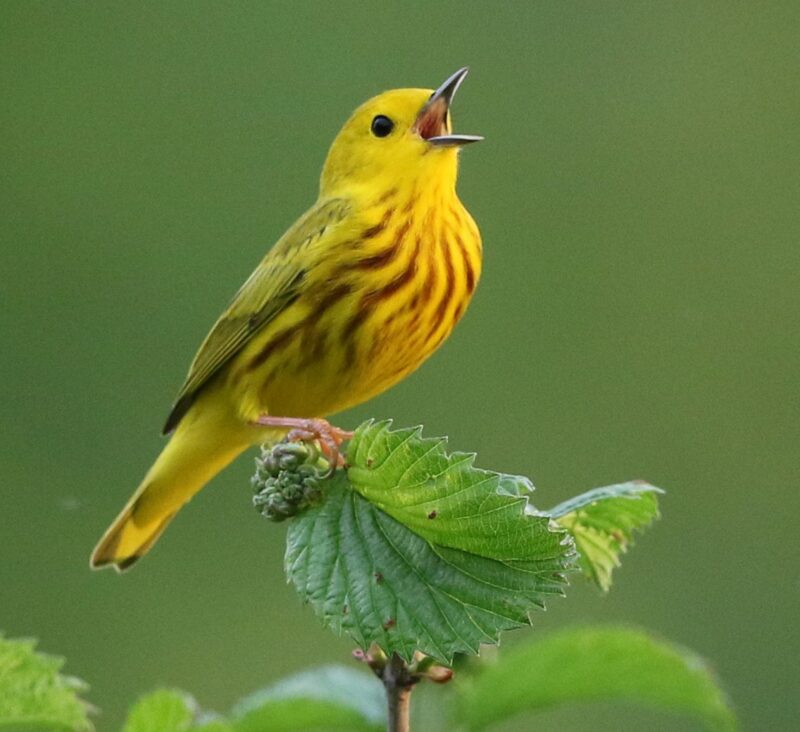Reimagining forest management with a more expansive vision

When a forest is managed holistically, the forest’s canopy can become foraging habitat for birds like the yellow warbler.
When I walk in the woods with people, I often invite them to reimagine the forest.
Whether you are a forester or a forest-lover, we all tend to focus on trees. While there is no question that trees are a vital component of forests, they aren’t everything. Reimagining forests means broadening our definition of “the forest” from “a bunch of trees” to a dynamic and diverse community of trees, plants, animals, insects, fungi and more.
When we allow ourselves to reimagine the forest, we can see that the way that the trees in a forest are growing is as vital as the trees themselves. We can see the importance of the composition (different species of trees) and structure (different sizes and ages of trees) of the trees in the forest, the importance of having some big trees (including big trees which are declining, dying, hollow and full of cavities), dead-standing trees (“snags”), lots of dead wood on the forest floor and healthy soils.
Each of these conditions is vital to the function of the forest community, its resilience and adaptability, the natural processes that make it work and the way that it changes over time. Each is a condition to which the tens of thousands of species that comprise the reimagined forest have adapted for millennia, and each is underrepresented in our modern forests.
As we reimagine what forests are, we also need to reimagine what it means to take care of them. Reimagining forest management means understanding that my job as a forester is to care for the reimagined forest in its entirety — not just its trees. My success should be measured not by my ability to keep every tree in the forest alive, but by my ability to support and enrich the forest community.
While forest management includes many different tools and techniques, one of the most powerful ways I can help the reimagined forest recover from the wounds of the past, endure the challenges of the present and move into an uncertain future is through the thoughtful and strategic cutting of trees.
If we think of forests as “a bunch of trees,” the cutting of the tree is a loss. If we reimagine forests, we can see that the cutting of a tree — as part of a holistic forest management approach — can be as profound a gift to the forest as its life. Following forest management, gaps in the forest’s canopy will become foraging habitat for birds and bats; the understory will bloom with a diverse mix of plants, shrubs and young trees; the trees and treetops on the forest floor will become rich communities of mosses, invertebrates and fungi which will benefit soil hydrology and help build richer soils. In the reimagined forest, the death of trees can help young forests become more like old growth forests, can help create habitat for species which are declining and under threat, and can help us actively respond to the many threats that our forests face.
If we reimagine forest management as a means to care for this reimagined forest (as it is often applied in Vermont today), the fact that forest management can be commercial is one of its greatest assets, and the mills, markets, foresters, loggers and truckers that make commercial forest management possible are vital to forests’ biodiversity, their integrity, their resilience.
Forest management is the only form of ecosystem restoration that can pay for itself and can even generate income that landowners can use to pay property taxes and other costs associated with keeping forests intact and healthy. As such, it can be applied on a much larger scale than any other form of restoration. In a world of non-local, non-renewable resources that cause harm to peoples and ecosystems across the globe, forest management is also the only form of ecosystem restoration that generates local, renewable resources.
Reimagining forests and forest management means forming a more holistic and expansive vision of what forests are and what it means to truly care for them. Doing what is necessary to protect forests, and all their pieces and parts, will often require us to make compromises as bittersweet as cutting a tree to enrich a reimagined forest.
(Ethan Tapper is the Chittenden County Forester for the Vermont Deptartment of Forests, Parks and Recreation. See what he’s been up to, check out his YouTube channel, sign up for his eNews and read articles he’s written.)

